steering Oldsmobile Achieva 1998 s Owner's Guide
[x] Cancel search | Manufacturer: OLDSMOBILE, Model Year: 1998, Model line: Achieva, Model: Oldsmobile Achieva 1998Pages: 356, PDF Size: 18.04 MB
Page 225 of 356

If You’re Stuck: In Sand, Mud,
Ice
or Snow
What you don’t want to do when your vehicle is stuck is
to spin your wheels too fast. The method known as
“rocking” can help you get out when you’re stuck, but
you must use caution.
IN:
If you let your tires spin at high speed, they can
explode, and you or others could be injured. And,
the transaxle or other parts of the vehicle can
overheat. That could cause an engine
compartment fire or other damage. When you’re
stuck, spin the wheels
as little as possible. Don’t
spin the wheels above
35 mph (55 kmh) as shown
on the speedometer.
I NOTICE:
Spinning your wheels can destroy parts of your
vehicle
as well as the tires. If you spin the wheels
too fast while shifting your transaxle back and
forth, you can destroy your transaxle.
For information about using tire chains on your vehicle,
see “Tire Chains” in the Index.
Rocking Your Vehicle To Get It Out
First, turn your steering wheel left and right. That will
clear the area around your front wheels.
If your vehicle has
the Enhanced Traction System, you should
turn the system
off. (See “Enhanced Traction System” in the Index.) Then
shift back and
forth between REVERSE (R) and a forward
gear, spinning the wheels as little as
possible. Release the
accelerator pedal while you
shift, and press lightly on the
accelerator pedal when the transaxle is in gear.
If that
doesn’t get you out after a few tries, you may need to be
towed out. If you do need to be towed out, see “Towing
Your Vehicle”
in the Index.
5-37
Page 229 of 356
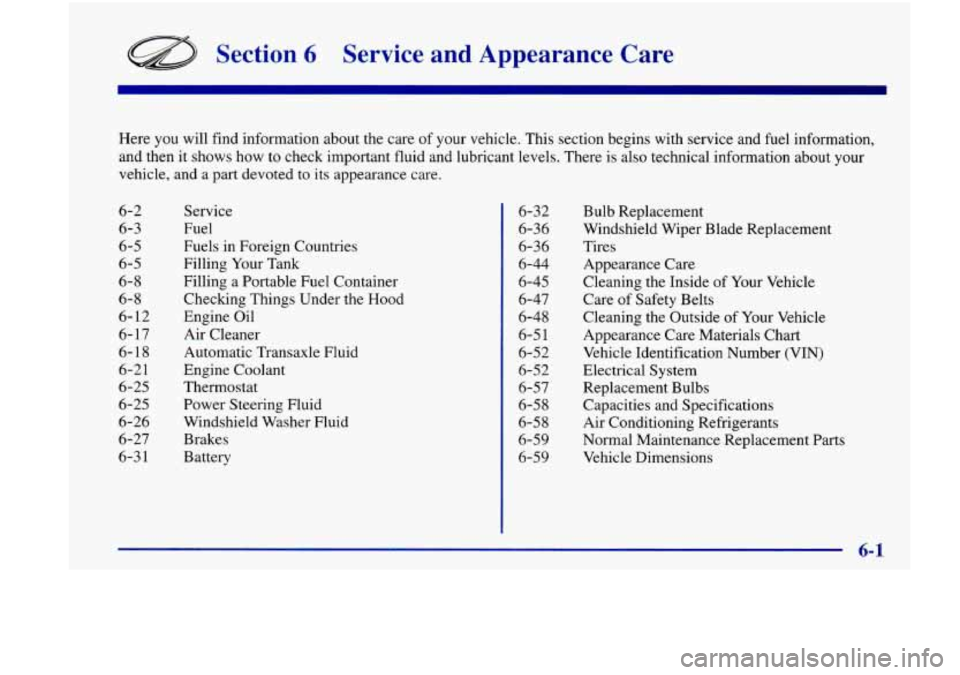
Section 6 Service and Appearance Care
Here you will find information about the care of your vehicle. This section begins with service and fuel information,
and then it shows
how to check important fluid and lubricant levels. There is also technical information about your
vehicle, and a part devoted to its appearance care.
6-2
6-3
6-5
6-5
6-8
6-8
6-
12
6- 17
6-18
6-2 1
6-25
6-25
6-26
6-27
6-3
1
Service
Fuel
Fuels in Foreign Countries
Filling Your Tank
Filling a Portable Fuel Container
Checking Things Under the Hood
Engine Oil
Air Cleaner Automatic Transaxle Fluid
Engine Coolant
Thermostat Power Steering Fluid
Windshield Washer Fluid Brakes
Battery 6-32
6-3 6 6-36
6-44
6-45
6-47
6-48
6-5
1
6-52
6-52
6-57
6-58
6-58
6-59
6-59 Bulb Replacement
Windshield Wiper
Blade Replacement
Tires
Appearance Care
Cleaning the Inside of Your Vehicle
Care
of Safety Belts
Cleaning the Outside
of Your Vehicle
Appearance
Care Materials Chart
Vehicle Identification Number (VIN)
Electrical System
Replacement Bulbs
Capacities and Specifications
Air Conditioning Refrigerants
Normal Maintenance Replacement Parts Vehicle Dimensions
Page 238 of 356
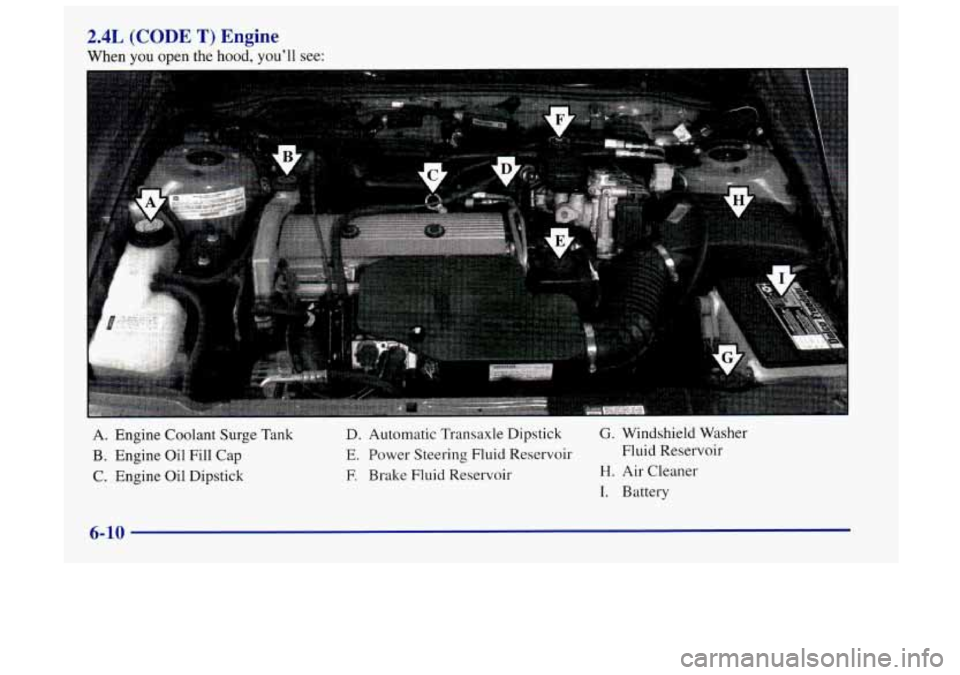
2.4L (CODE T) Engine
When you open the hood, you’ll see:
A. Engine Coolant Surge Tank
B. Engine Oil Fill Cap
C. Engine Oil Dipstick
D. Automatic Transaxle Dipstick
E. Power Steering Fluid Reservoir
E Brake Fluid Reservoir
G. Windshield Washer
Fluid Reservoir
H. Air Cleaner
1. Battery
Page 239 of 356
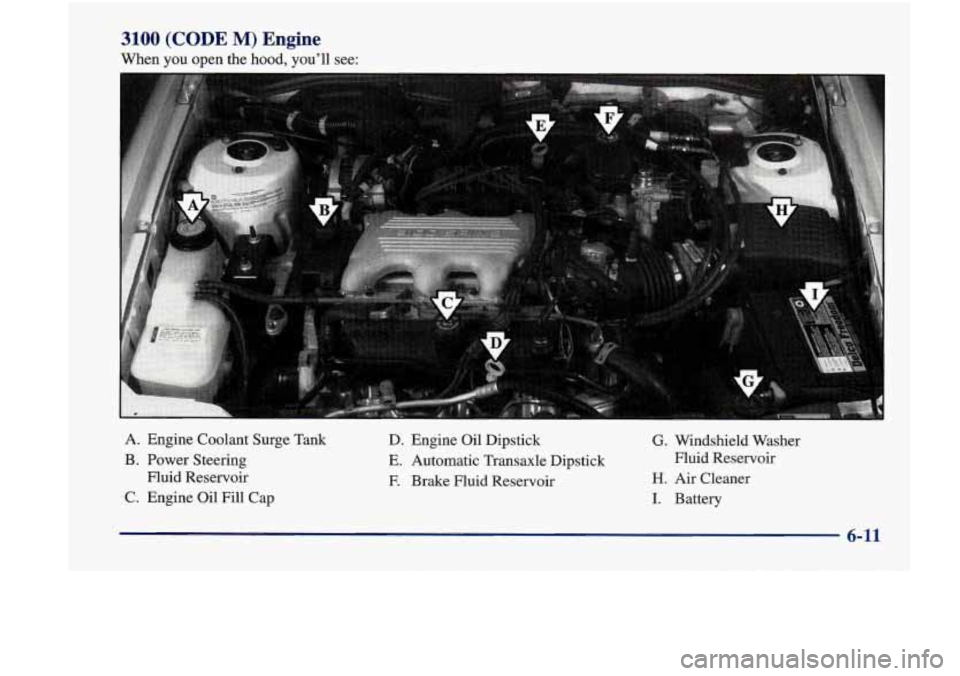
3100 (CODE M) Engine
When you open the hood, you’ll see:
I
A. Engine Coolant Surge Tank
B. Power Steering Fluid Reservoir
C. Engine Oil Fill Cap D. Engine
Oil Dipstick
E. Automatic Transaxle Dipstick
F. Brake Fluid Reservoir
G. Windshield Washer
Fluid Reservoir
H. Air Cleaner
I. Battery
6-11
Page 253 of 356
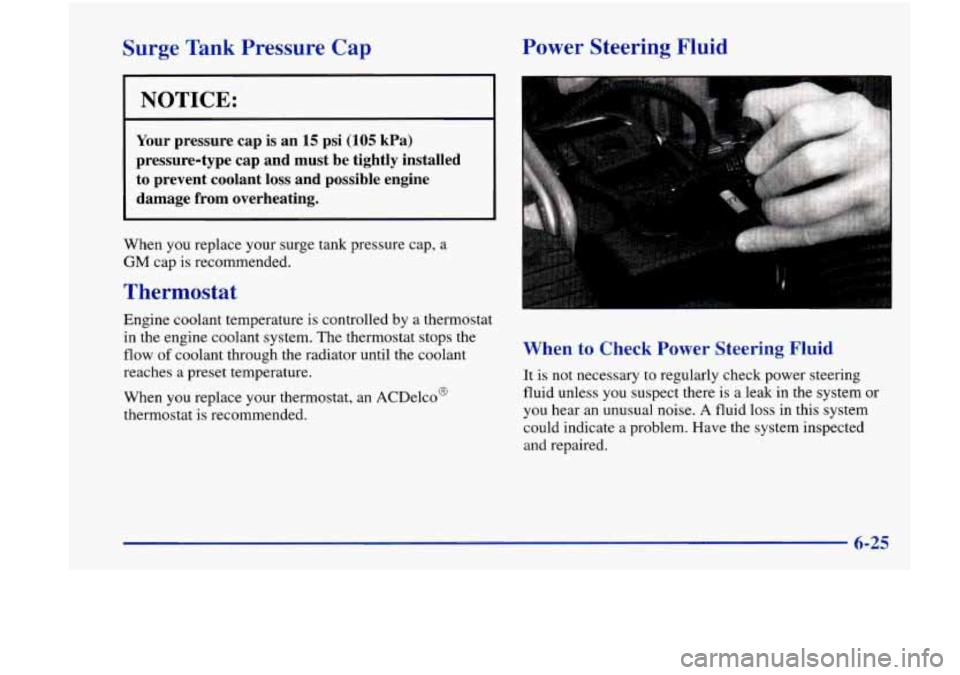
Surge Tank Pressure Cap Power Steering Fluid
I NOTICE:
Your
pressure cap is an 15 psi (105 kPa)
pressure-type cap and must
be tightly installed
to prevent coolant loss and possible engine
damage from overheating.
When you replace your surge tank pressure cap, a
GM cap is recommended.
Thermostat
Engine coolant temperature is controlled by a thermostat
in the engine coolant system. The thermostat stops the
flow
of coolant through the radiator until the coolant
reaches a preset temperature.
When you replace your thermostat, an ACDelco@
thermostat is recommended. When to Check Power Steering Fluid
It is not necessary to regularly check power steering
fluid unless you suspect there
is a leak in the system or
you hear an unusual noise. A fluid loss in this system
could indicate
a problem. Have the system inspected
and repaired.
Page 254 of 356

How To Check Power Steering Fluid
When the engine compartment is cool, wipe the cap and
the top
of the reservoir clean, then unscrew the cap and
wipe the dipstick with a clean rag. Replace the cap and
completely tighten it. Then remove the cap again and
look at the fluid level
on the dipstick.
The level should be at the
“C” mark. If necessary, add
only enough fluid to bring the level up to the mark.
What to Use
To determine what kind of fluid to use, see
“Recommended
Fluids and Lubricants” in the Index.
Always use the proper fluid. Failure to use the proper
fluid can cause leaks and damage hoses and seals.
Windshield Washer Fluid
What to Use
When you need windshield washer fluid, be sure to read
the manufacturer’s instructions before use.
If you will be
operating your vehicle in an area where the temperature
may fall below freezing, use a fluid that has sufficient
protection against freezing.
Adding Washer Fluid
Open the cap labeled WASHER FLUID ONLY. Add
washer fluid until the tank
is full.
6-26
Page 282 of 356
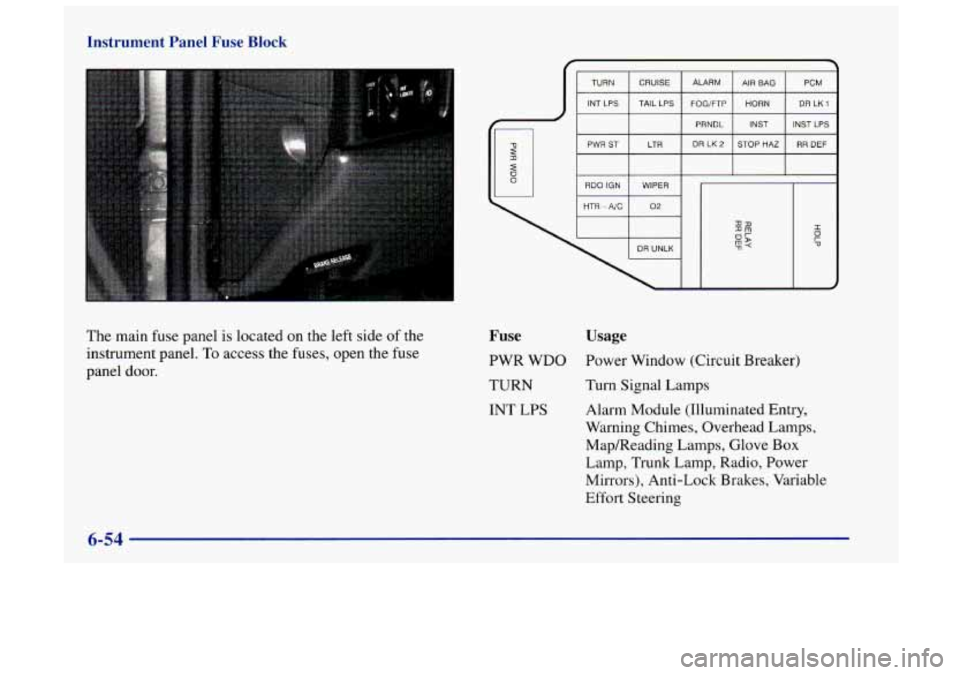
Instrument Panel Fuse Block
The main fuse panel is located on the left side of the
instrument panel. To access the fuses, open the fuse
panel door. Fuse
PWR WDO
TURN
INT LPS
Usage
Power Window (Circuit Breaker)
Turn Signal Lamps
Alarm Module (Illuminated Entry,
Warning Chimes, Overhead Lamps,
Mapmeading Lamps, Glove
Box
Lamp, Trunk Lamp, Radio, Power
Mirrors), Anti-Lock Brakes, Variable
Effort Steering
6-54
Page 284 of 356
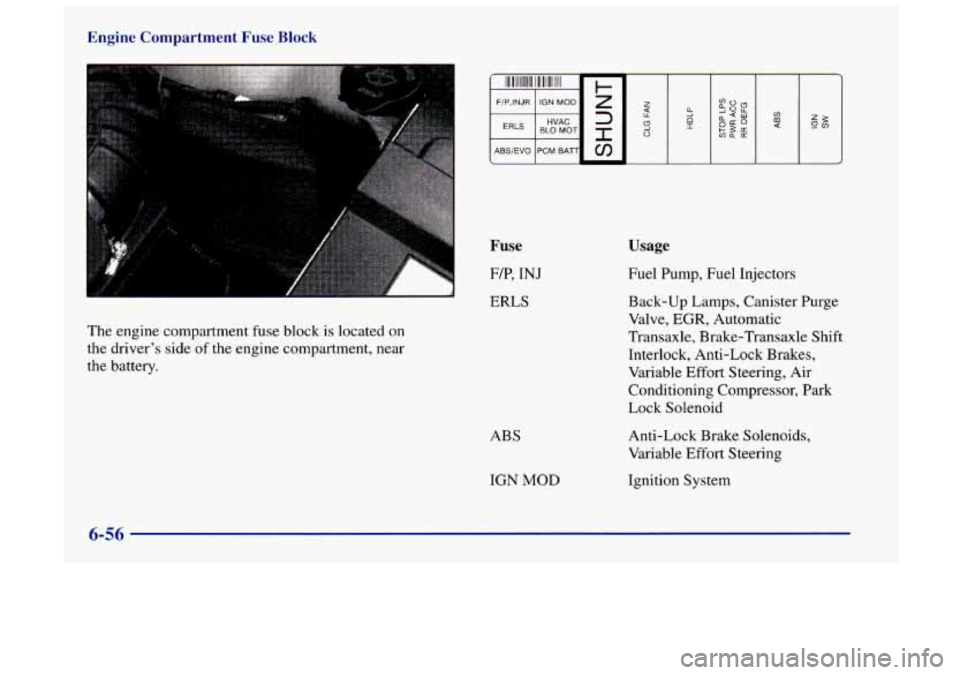
Engine Compartment Fuse Block
I
Fuse
FP,
INJ
ERLS
The engine compartment fuse block
is located on
the driver’s side of the engine compartment, near
the battery.
ABS
IGN
MOD
Usage
Fuel Pump, Fuel Injectors
Back-up Lamps, Canister Purge
Valve,
EGR, Automatic
Transaxle, Brake-Transaxle Shift
Interlock, Anti-Lock Brakes,
Variable
Effort Steering, Air
Conditioning Compressor, Park
Lock Solenoid
Anti-Lock Brake Solenoids,
Variable
Effort Steering
Ignition System
6-56
Page 285 of 356
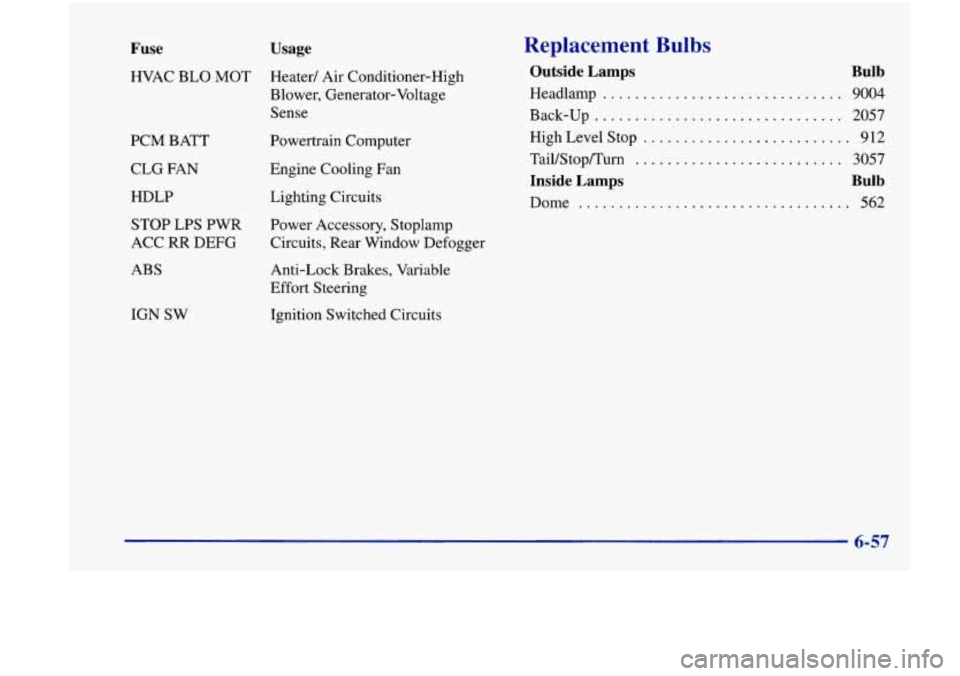
Fuse Usage
HVAC BLO MOT Heater/ Air Conditioner-High
Blower, Generator-Voltage
Sense
PCM BATT
CLG
FAN
HDLP STOP LPS PWR
ACC
RR DEFG
ABS
IGN SW Powertrain Computer
Engine Cooling Fan
Lighting Circuits
Power
Accessory, Stoplamp
Circuits, Rear Window Defogger
Anti-Lock Brakes, Variable
Effort Steering
Ignition Switched Circuits
Replacement Bulbs
Outside Lamps Bulb
Headlamp .............................. 9004
Back-up
............................... 2057
High Level Stop .......................... 912
Tail/Stop/Turn
.......................... 3057
Inside Lamps Bulb
Dome .................................. 562
Page 297 of 356
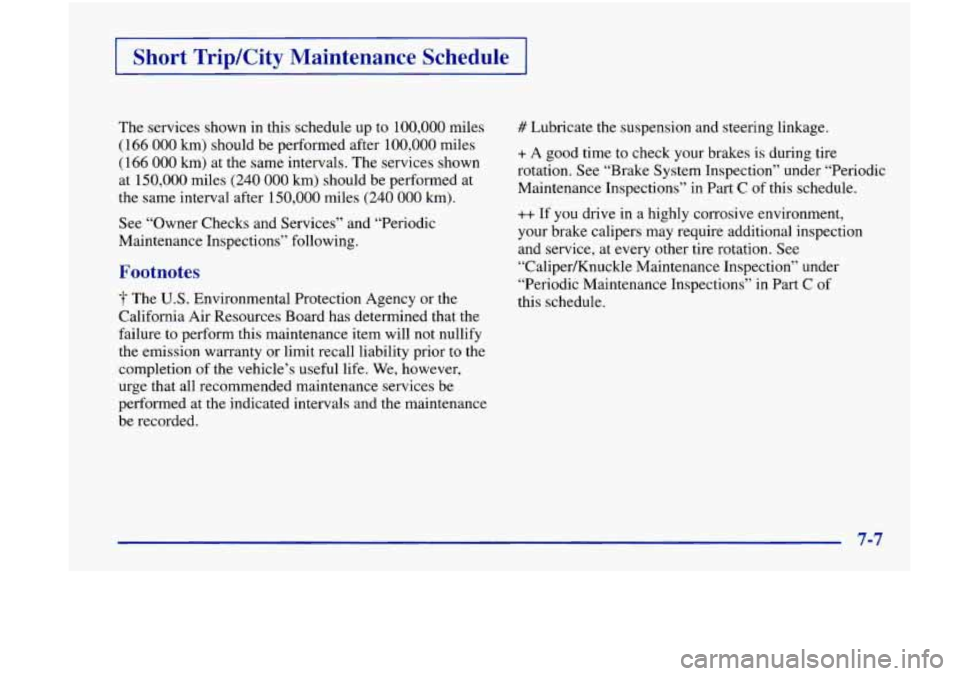
1 Short TripKity Maintenance Schedule I
The services shown in this schedule up to 100,000 miles
(166
000 km) should be performed after 100,000 miles
(166
000 km) at the same intervals. The services shown
at 150,000 miles
(240 000 km) should be performed at
the same interval after 150,000 miles
(240 000 km).
See “Owner Checks and Services” and “Periodic
Maintenance Inspections” following.
Footnotes
-f The U.S. Environmental Protection Agency or the
California Air Resources Board has determined that the
failure to perform this maintenance item will not nullify
the emission warranty
or limit recall liability prior to the
completion of the vehicle’s useful life. We, however,
urge that all recommended maintenance services be
performed at the indicated intervals and the maintenance
be recorded.
# Lubricate the suspension and steering linkage.
+ A good time to check your brakes is during tire
rotation. See “Brake System Inspection” under “Periodic
Maintenance Inspections” in Part C of this schedule.
++ If you drive in a highly corrosive environment,
your brake calipers may require additional inspection
and service, at every other tire rotation. See
“CaliperKnuckle Maintenance Inspection’’ under
“Periodic Maintenance Inspections” in Part C
of
this schedule.
7-7